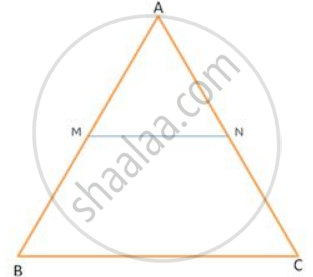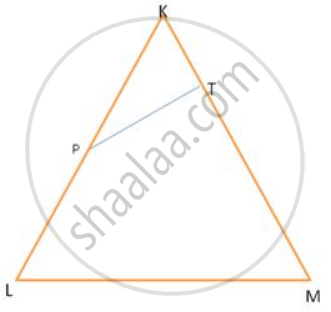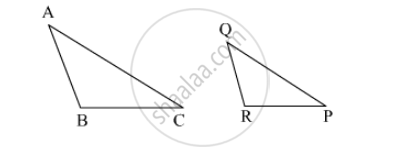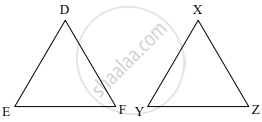Topics
Number Systems
Real Numbers
Algebra
Polynomials
Pair of Linear Equations in Two Variables
- Introduction to linear equations in two variables
- Graphical Method
- Substitution Method
- Elimination Method
- Cross - Multiplication Method
- Equations Reducible to a Pair of Linear Equations in Two Variables
- Consistency of Pair of Linear Equations
- Inconsistency of Pair of Linear Equations
- Algebraic Conditions for Number of Solutions
- Simple Situational Problems
- Pair of Linear Equations in Two Variables
- Relation Between Co-efficient
Quadratic Equations
- Quadratic Equations
- Solutions of Quadratic Equations by Factorization
- Solutions of Quadratic Equations by Completing the Square
- Nature of Roots of a Quadratic Equation
- Relationship Between Discriminant and Nature of Roots
- Situational Problems Based on Quadratic Equations Related to Day to Day Activities to Be Incorporated
- Application of Quadratic Equation
Arithmetic Progressions
Coordinate Geometry
Lines (In Two-dimensions)
Constructions
- Division of a Line Segment
- Construction of Tangents to a Circle
- Constructions Examples and Solutions
Geometry
Triangles
- Similar Figures
- Similarity of Triangles
- Basic Proportionality Theorem (Thales Theorem)
- Criteria for Similarity of Triangles
- Areas of Similar Triangles
- Right-angled Triangles and Pythagoras Property
- Similarity of Triangles
- Application of Pythagoras Theorem in Acute Angle and Obtuse Angle
- Triangles Examples and Solutions
- Concept of Angle Bisector
- Similarity of Triangles
- Ratio of Sides of Triangle
Circles
Trigonometry
Introduction to Trigonometry
- Trigonometry
- Trigonometry
- Trigonometric Ratios
- Trigonometric Ratios and Its Reciprocal
- Trigonometric Ratios of Some Special Angles
- Trigonometric Ratios of Complementary Angles
- Trigonometric Identities
- Proof of Existence
- Relationships Between the Ratios
Trigonometric Identities
Some Applications of Trigonometry
Mensuration
Areas Related to Circles
- Perimeter and Area of a Circle - A Review
- Areas of Sector and Segment of a Circle
- Areas of Combinations of Plane Figures
- Circumference of a Circle
- Area of Circle
Surface Areas and Volumes
- Surface Area of a Combination of Solids
- Volume of a Combination of Solids
- Conversion of Solid from One Shape to Another
- Frustum of a Cone
- Concept of Surface Area, Volume, and Capacity
- Surface Area and Volume of Different Combination of Solid Figures
- Surface Area and Volume of Three Dimensional Figures
Statistics and Probability
Statistics
Probability
Internal Assessment
Definition
What can you say about the similarity of two triangles?
Two triangles are similiar, if
(i) their corresponding angles are equal and
(ii) their corresponding sides are in the same ratio (or proportion).
Notes
Note that if corresponding angles of two triangles are equal, then they are known as equiangular triangles.
A famous Greek mathematician Thales gave an important truth relating to two equiangular triangles which is as follows: The ratio of any two corresponding sides in two equiangular triangles is always the same.
It is believed that he had used a result called the Basic Proportionality Theorem (now known as the Thales Theorem) for the same.
Theorem
1)Thales Theorem or Basic Proportionality Theorem(BPT): If a line is drawn parallel to one side of a triangle to intersect the other two sides in distinct points, the other two sides are divided in the same ratio.
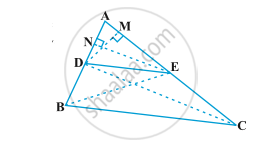
Given: DE || BC
Construction: Draw EN ⊥ AB and DM ⊥ AC. Also join B to E and D to C.
To Prove: `"AD"/"DB" = "AE"/"EC"`
Proof: Now we know that area of triangle= `(1/2 × base × height)`
area of ∆ ADE = `1/2× "AD"× "EN"`
Area of ∆ ADE is denoted as ar(ADE).
So, ar(ADE)= `1/2 × "AD" × "EN"`
Similarly, ar(BDE)= `1/2 × "DB" × "EN"`
Here in ∆ BDE, the height is EN, because if we extend the base DB to BA then we get EN ⊥ BA.
If we take ratios of areas of triangles,
`"ar(ADE)"/ "ar(BDE)"`= `(1/2 × "AD" × "EN")/ (1/2 × "DB" × "EN")`
Therefore, `"ar(ADE)"/ "ar(BDE)"= "AD"/"DB"` .....eq1
Now, `"ar(ADE)" = 1/2 × "AE" × "DM"`
and, `"ar(DCE)"= 1/2 × "EC" × "DM"`
Here again, in ∆DCE, the height is DM, because if we extend the base EC to CA then we get DM ⊥ CA.
If we take ratios of areas of triangles,
`"ar(ADE)"/"ar(DCE)"= "1/2 × AE × DM"/ "1/2 × EC × DM"`
`"ar(ADE)"/"ar(DCE)"= "AE"/"EC"` ........eq2
We already know that, if two triangles re on the same base and between the same parallels then the areas of that two triangles are same.
Therefore, ar(BDE)=ar(DCE) ......eq3
From eq2 and eq3
`"ar(ADE)"/"ar(BDE)"= "AE"/"EC"` .......eq4
From eq1 and eq4
`"AD"/"DB" = "AE"/"EC"`
Hence proved.
2) Converse of Thales Theorem: If a line divides any two sides of a triangle in the same ratio, then the line is parallel to the third side.

Given: `"AD"/"DB" = "AE"/"EC"`
Construction: Draw DE′ || BC
To prove: DE || BC
Proof: Let DE′ || BC ......(By construction)
`"AD"/"DB" = "AE′"/"E′C"` ........eq1 (By BPT)
But, `"AD"/"DB" = "AE"/"EC"` ..........eq2 (Given)
From eq1 and eq2
`"AE′"/"E′C" = "AE"/"EC"`
Add 1 both the sides
`"AE′"/"E′C" +1 = "AE"/"EC" +1`
`"AE′+E′C"/ "E′C" = "AE+EC"/ "EC"`
`"AC"/"E′C"= "AC"/"EC"`
`"EC" = "E′C"`
This is possible only when E′ and E coincide
Therefore, DE || BC
Hence proved.
